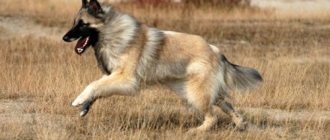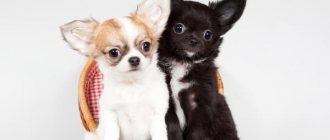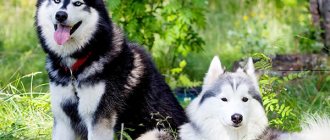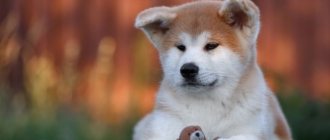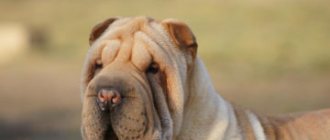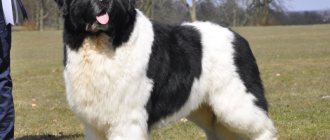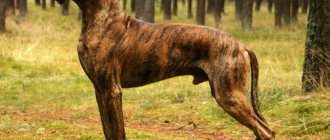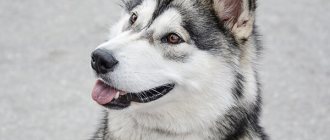| Origin | Switzerland |
| Usage | Herd protection, grazing, pack animal in the mountains |
| Color | A combination of three colors - black (main), red along the line of the paws and in the form of specks on the muzzle, white - from the forehead to the belly. |
| Dimensions | Large Swiss - from 50 to 68 kg; height – from 60 to 73 cm. Bernese – from 36 to 50 kg; height – from 58 to 70 cm. Entlebucher – 25 – 30 kg; height – from 42 to 50 cm. Appenzeller – from 22 to 32 kg; height – from 47 to 58 cm. |
| Lifespan | Large Swiss and Bernese Shepherds – 10 – 12 years. Entlebucher and Appenzeller live from 12 to 15 years. |
Sennenhunds have a long history. Dogs resembling them in appearance were discovered during excavations of a legionnaire camp of the Roman Empire. The agile dog helped protect flocks of sheep from predators. They retain their shepherd's inclinations even when living in apartments and take care of the safety of family members. The question of dog breed ownership remains unclear to this day: to which group they should be classified. It is believed that Sennenhunds may be relatives of Schnauzers, Molossians or Wolf-Molossians.
Other names for Sennenhunds are herding dogs and Swiss shepherds.
Care and maintenance
Bernese Shepherds are clean and easily adapt to different living conditions.
This breed is better suited for a private home, but you can keep a Bernese Mountain Dog in an apartment. In the first case, a fenced enclosure with a booth is suitable for a comfortable life for a shepherd dog, in the second - a dedicated place on a glazed balcony, where a small kennel is organized during the winter.
Before moving on to considering the main features of nutrition, walking and grooming, it should be noted that, in addition to them, dogs:
- wipe the ears weekly using a special product;
- brush your teeth if necessary;
- carry out eye examination and treatment;
- trim the claws if they do not grind down on their own;
- inspect after walks for the presence of ticks in the fur.
Following these simple rules will help your Bernese Shepherd stay healthy.
Nutritional Features
Adult dogs are fed twice a day. If desired, they switch to a single meal, but most breeders adhere to a two-time diet - morning and evening.
Since dogs of this breed are not particularly energetic and tend to be overweight, it is better not to overfeed them and control the portion size.
If the main diet of a shepherd dog is dry food, then preference is given to special hypoallergenic food with a fat content of no more than 16% and a high protein content.
If the Bernese eats natural products, the basis of its diet should be lean meat (about 350 g per day per 10 kg of dog weight). Several times a week, meat is replaced with boiled sea fish.
Shepherd dogs should not be fed fatty meats or starchy vegetables, but vegetables and cereals are required in the diet. The total share of cereals per day is no more than 10%.
It is recommended to give cottage cheese and fermented milk products to puppies daily, and less often to adults. Berna is treated to an egg 1–2 times a week.
For dessert, shepherd dogs will happily crunch on an apple, pear or banana.
Walking and physical activity
It can be said about the Bernese Mountain Dog breed that it is not particularly energetic and does not require much physical activity.
If the dog is kept in an apartment, then to maintain health it should be walked twice a day for at least two hours. At the same time, the Bernese would rather prefer an easy walk with the owner than a long-distance race.
A shepherd dog can be trained to pull a sled or cart, and he will happily take children on them.
Training and education
Bernese Shepherds are intelligent, but training them requires patience and persistence. Training of the Mountain Dog breed begins at an early age.
Bernese Mountain Dogs mature late - around 2 years old. It is better to leave complex training for this time, but from the age of 2 months the puppy begins to learn the commands “No!”, “Ugh!”, “Place!”, “Come to me!”.
To do this, just stock up on goodies for encouragement and devote about 10–15 minutes a day to training. The main thing is that these activities take place in the form of a game and that the puppy enjoys it.
At the age of 4 months, the dog begins to cut teeth. To stop a puppy from biting, you need to lightly squeeze the nose and sternly shout. A little pain and tone will help the puppy understand that human hands are not a toy and you shouldn’t sharpen your teeth on them.
Due to the friendliness and sociability of the breed, the puppy must be weaned from taking treats from the hands of strangers (even relatives and friends).
Grooming
Grooming for the Bernese Mountain Dog is combing, which is of great importance for the beauty and health of the dog. The coat of this breed is long and dense and requires brushing at least once a week.
During periods of shedding, you need to brush your shepherd almost every day.
For this procedure, a wide-tooth comb and a special brush are used to comb the undercoat.
Grooming also includes trimming the fur on the paws between the toes. Bernese Shepherds are not given haircuts.
Bernese Mountain Dogs also have a drop of Newfoundland blood in their veins. This is probably why Bernese love to swim and don’t mind taking a bath. Although their coat does not require frequent washing.
Wash your dog no more than once every 3 months. The use of human shampoos is prohibited. Detergents must be carefully selected, since Berns are often allergic to them.
In winter, you should avoid baths - the thick coat makes it difficult to dry a shepherd dog, and wet undercoat often leads to fungus or dermatitis.
Mating
Swiss Cattle Dogs become adults at 2 years of age. Therefore, despite the fact that dogs have their first heat every year and then every six months, they cannot be bred until they are fully mature. After birth, the next mating takes place a year later. Bitches over 7 years old do not participate in breeding.
How much do mountain dog puppies cost?
In the nursery you can buy puppies of different categories with the following pedigree:
- Without participation in exhibitions and breeding - from 20,000 to 25,000 rubles.
- For an exhibition career and breeding - from 35,000 to 40,000 rubles.
- Rare species (entlebucher) - from 40,000 to 60,000 rubles.
Breed standard
Sennenhunds are one of the few breeds for which there are no strict color requirements. The standard stipulates only three-color coat coloring and strictly black as the main color. The pattern is almost always asymmetrical; torn edges of the white color are allowed, but due to the length of the hair this is almost never noticeable to the eye.
When choosing a puppy, instead of color, the main attention should be paid to the dog’s physique and other features that determine the breed standard:
1. Head. Massive and wide. Almost complete absence of a frontal groove on the skull. Moderately long muzzle, in harmony with the size of the head. The transition from skull to muzzle is smooth.
2. Eyes. They have an almond shape, the planting is not deep. The color is almost always brown, closer to a dark shade.
3. Ears. Not too massive, have a triangular shape. They always hang down, except for the period when the dog is excited - the back of the ears rises slightly.
Bernese Mountain Dog family
4. Jaw. Powerful, but slightly smaller than those of the related Molosser Schnauzer. The bite can be scissor- or pincer-like.
5. Body. Very strong and externally voluminous. The chest, when viewed from the front, descends just below the elbows of the forelegs. Ribs with good rounding. The back is almost perfectly horizontal, only the transition from the neck is rounded.
6. Silhouette. A somewhat disproportionate length of the body is noticeable to the eye, the ratio to the height at the withers is 10:8.
7. Movement. When running, the paw span is wide, and a mincing manner of movement is not encouraged.
8 Tail. Length just below the hock. Always straight out, hangs down when calm, parallel to the ground when the dog moves.
9. Paws. The front ones are almost perfectly straight; due to the thick fur on the chest, they look short. The hind legs have well-developed thigh muscles and pronounced angles. The presence of profitable fingers is prohibited.
10. Testes – well developed, descend into the scrotum no later than the age of 18 months.
11. Color – only tri-color, with a black main background, white chest, muzzle and feet, red markings on the muzzle, paws and neck. The black color often has characteristic tan marks - a characteristic feature of the breed.
One of the main standards of the breed is its fearless character. The Bernese Mountain Dog perceives strangers calmly, but warily. Fearlessness should be evident even in puppies.
When choosing an animal, it is recommended to pay attention to its behavior - the puppy should not be afraid of a stranger and should not be given into his hands
Disqualifying defects include the following:
- The light shade of the eyes is usually blue.
- The shape of the tail is “broken” or rolled up.
- Lack of a third color in the color, excessively frequent pigmentation, asymmetry of color on the face.
- Aggressive character.
It is impossible to assess the color of a future pet until it reaches puberty. Bernese Mountain Dog puppies have a soft coat instead of a hard one during the first six months of life. The dog matures at the age of 1.5 years.
How to choose a puppy
Whether you will have to face unnecessary problems in the future depends on the correct choice of a puppy. Therefore, you need to be very careful here.
First of all, you should pay attention to the appearance of the dog. The coat should be thick, clean, without tangles and, especially, bald patches.
It is also worth examining your potential pet for color defects.
However, if there is no desire to enter a dog into competitions and get elite offspring, then such shortcomings can hardly seriously influence the choice. On the contrary, you can save a lot of money - the demand for “rejected” puppies is unlikely to be high.
For reference! The breed cannot be called cheap - the cost of a puppy ranges from 10 to 80 thousand.
It is very important to assess the psychological state of the future pet
- The puppy should be cheerful, active and active.
- Curiosity is also not alien to him - he will probably want to sniff a new, unfamiliar person.
- But at the same time, there should be a healthy mistrust - when you try to pick it up, the puppy should retreat.
All of these are indicators of the dog’s psychological health. Of course, any deviations may not mean anything, but in some cases they have a negative impact - the grown dog either turns out to be very cowardly, or overly friendly, ready to fawn over any stranger.
Keeping these simple rules in mind, every dog lover will not only be able to have a suitable pet, but also ensure a long and happy life for him.
Description of the breed with photos
The Bernese Mountain Dog is a large and beautiful dog, somewhat reminiscent of its exterior. Its highlight is its thick, long and curly fur, which you just want to stroke. By the way, Mountain Dogs are friendly and usually do not refuse such affection.
Color
Most often, Mountain Dogs are tri-colored, with the main color being black. Near the eyes and on the tail there are red, or rather brownish-red, inclusions, and between the eyes, on the chest and tail there are white ones. Sometimes the entire chest, as well as the paws, are white. However, a primary color other than black is considered a disqualifying fault.
Appearance - standard
Main points on the breed standard:
- This is a strong and agile working dog, stocky rather than elongated, harmonious and balanced. The ratio of body length and height at the withers should be 10:9.
- The tail is fluffy, reaching to the hock joint. When calm, it hangs down, and when excited and moving, the dog can lift it slightly above the level of the back.
- The head is strong, of medium length; the skull in profile and when viewed from the front should be slightly convex, and the transition to the neck should be pronounced, but not too much. The muzzle is straight. The nose and lips are always black, the bite is full, strong, scissor-shaped. The teeth are white, with incisors located in one line.
- Sennenhunds have dark brown, almond-shaped eyes, and their ears are triangular, medium in size, slightly rounded at the end. The neck is strong and muscular, of medium length, with a powerful scruff, leading into a strong and compact body.
- The chest should be wide, the back should be straight and strong, and the stomach should not be tucked up.
- The forelimbs are straight and parallel to each other, the hind limbs, when viewed from the rear, are straight and parallel to each other, with strong bones and well-developed muscles.
Dimensions: how much does it weigh
Height - for males - 63.5-70 cm, for females - 60-63 cm. The weight of an adult dog is on average approximately 40-44 kg, while males can reach 50 kg, and females - 48.
Height at withers for males - 63.5 - 70 cm, for females - 60 - 63 cm. Weight - 40 - 44 kg.
Weight and height chart:
Weight by month
Puppy weight by month (age):
- 1 month - weight 2.5 - 4.5 kg, height 20 - 25 cm;
- 2 month – weight 6 – 10 kg, height 28 – 36 cm;
- 3 month - weight 11 - 17 kg, height 36 - 44 cm;
- 4 months – weight 15 – 26 kg, height 42 – 51 cm;
- 5-6 months - weight 25 - 38 kg, height 50 - 61 cm;
- 7-8 months - weight 34 - 45 kg, height 55 - 67 cm;
- 9-12 months - weight from 30 to 50 kg, height - 58 - 70 cm. The animal will no longer grow, but over the next few years it can gain up to 4-13 kg of weight.
1 month
2 months
3 months
4 months
Puppy 5 months in the photoPhoto 6 months
Howl and bark
The bark of Bernese Mountain Dogs is short and sharp. This animal will not bark for no reason, which is why it is valued. But if your pet gives a voice, it’s definitely not without reason, because Bernese are excellent watchdogs.
The breed is not prone to howling, but it is worth teaching your baby Mountain Dog to somehow entertain himself on his own if you are going to leave him alone in the apartment. Otherwise, the animal may discover howling talents that are uncharacteristic for the breed.
Distinctive features
The Entlebucher Mountain Dog is easily recognized by its characteristic tricolor coat, floppy ears and intelligent look.
The breed standard provides the following requirements:
- The head is proportional to the body, wedge-shaped, with parallel straight lines of the muzzle and skull, their length ratio is 9:10. The skull is flattened, broad, slightly tapering towards the muzzle, without becoming pointed. The stop is weak.
- The nose is black, protrudes slightly in front, the bridge of the nose is flat.
- Lips with only black pigmentation.
- Scissor bite, let's say straight. The absence of 1-2 PM1 is acceptable, the absence of M3 does not affect the assessment.
- The eyes are small, round, the color of the iris is rich brown, the darkest possible shades. Black edging.
- The neck is of moderate length, muscular, and forms a smooth transition into the body.
- The ears are small, triangle-shaped, rounded at the tips, hanging. They have a high and wide stance.
- The tail is of standard length or shortened from birth, and should not be curled over the back.
- The body is strong, slightly elongated. Height at withers relates to length in proportion 8:10. The back is level, not narrow, the croup is long, slightly sloping. Strong, flexible lower back. The sternum is wide and deep. Medium round ribs. The stomach is slightly tucked.
- The legs are short, with pronounced muscles, do not look heavy, parallel, the distance between the limbs is average. The shoulder blades are oblique, elongated, approximately the same length as the shoulder. The pasterns are short, appear slightly bent from the side, and straight from the front. The thighs are wide, long, equal to the shins, forming an obtuse angle with them. The paws are rounded, the claws are small.
- The coat is hard, straight, short in length, and has a dense undercoat. On the background black there are red markings: above the eyes, on the cheekbones, muzzle, throat, chest, paws. Light fragments occur at the tip of the tail; from the top of the skull and along the bridge of the nose, not interrupted; from the chin to the chest; on the limbs, to the level of the metacarpus, metatarsus; perhaps a small spot on the nape of the neck. The undercoat is deep gray or brown.
Deviations from the standard are
- Unbalanced character;
- Rounded skull;
- Explicit stop;
- Undeveloped muscles;
- Narrowed head;
- Short/long muzzle;
- Missing teeth;
- “Humpbacked” bridge of the nose;
- Light, desaturated shade of the iris;
- “Fish”, slanting eyes;
- Shortened back, sagging or hunchbacked;
- “Inverted” legs;
- Interruption of white markings on the face and chest;
- Long paw/fingers;
- Cow position;
- Ears are folded, too small, pointed or deep set;
- White “collar”;
- Lack of light spots on some paws;
- Absolutely black head.
Disqualifying signs:
- Aggressive behavior or timidity of the animal;
- Yellow, blue eyes;
- Turn of the century;
- Malocclusion;
- Tail curled into a “ring” over the back;
- Size mismatch;
- Long coat length, insufficient rigidity, lack of undercoat;
- Not tricolor, or the base color is not black.
Nutrition
Swiss Mountain Dog puppies and adults need proper nutrition. It has a great impact on their health. For example, puppies grow quite quickly, which is bad for their joints. Therefore, during the growth period it is necessary to give them vitamin supplements, as well as substances such as calcium, magnesium and phosphorus.
We must not forget about the breed’s tendency to food allergies, although it is quite rare - when composing your pet’s diet, it is better to stick to neutral foods. It is necessary to review the diet and consult a veterinarian if the dog has unusual discharge from the eyes and ears, hair loss, swelling and scratching - obvious signs of allergies.
Crazy racing of Swiss Mountain Dogs
Half or most of your puppy's diet should consist of simple animal proteins (proteins). It is also preferable to give your pet dairy products. To prevent caries and tartar, dogs are advised to consume soft cartilage or special food and food sticks. Dental disease is easier to prevent than to treat. But if the animal still gets sick, it is necessary to take it to the veterinarian for teeth cleaning.
Character of the Mountain Dog
The pet has a surprisingly affectionate and kind character. The intimidating size may not seem suitable for the heart of a good-natured person. The Bernese Mountain Dog and children get along well, because the dog loves kids. But you shouldn’t leave a small child alone with a large animal: the dog may accidentally hit the baby. But older children will definitely enjoy playing with a balanced, friendly dog.
The pet is capable of small bursts of activity, but cannot become active for a long time. An adult Mountain Dog even becomes lazy at times and lies around a lot. The Berner puppy is more energetic. The owner will have to spend a lot of time playing with the growing pet. A dog’s psychological maturation occurs up to 2 years of age, during which it is characterized by increased activity.
Positive character traits of a pet are in the overwhelming majority. Among them are:
- Lack of innate aggression.
- There are no instincts of a hunting or fighting dog.
- Calm attitude towards strangers.
- Moderate animal activity.
- Berner's patient, positive attitude towards children.
The big, affectionate pet has a sweet “smile.” Just look at the photo of the Bernese Mountain Dog to be convinced. Due to the structure of its muzzle, a pet with its mouth slightly open seems to be smiling at a person.
Despite the strong attachment to the family, the pet does not disdain communicating with other people. This trait is rarely found in large pets. But a pet cannot be called indiscriminate - the dog chooses a single person as its owner.
For random inconveniences caused by a child, the dog will not take revenge or respond with aggression. The breed gets along well with other pets. The instincts of a hunter or fighter are completely absent from the pet. If another animal claims territory, the nature of the Bernese Mountain Dog will prompt you to move away.
But don’t think that dogs don’t need training. Large sizes already pose a danger to other pets, especially males. Males love to compete with each other, showing aggression. You can avoid unpleasant consequences by consistently raising your Berner puppy. The dog strives to please the owner, and not to dominate him, so training is not particularly difficult.
Socialization
The Mountain Dog, having a friendly character, treats all family members with equal love, although it becomes attached to one person. Herding instincts are inherent at the genetic level, so even a dog who is passionate about play always controls the safety of the “herd.”
Sennenhunds cannot stand being alone. A change of owners can negatively affect the psychological state of the animal.
Herding Shepherd Dogs show politeness to strangers, but do not allow familiarity from strangers. Pets are treated like family members. They don't compete for the top position. Domestic cats often take advantage of their gentleness and good nature, from which the Mountain Dog would prefer to retreat rather than engage in a fight. They love to play with children.
All Mountain Dogs have highly developed intelligence, are easy to train, and are good listeners. Grosses require additional mental stress.
Necessary care
The basis for the health of a Greater Swiss Shepherd is a balanced, complete diet. Improper feeding causes joint injuries and brittle bones.
A small puppy needs to be provided with six divided meals a day. As they grow older, the frequency of feeding is reduced to half.
The basis of the diet is animal protein. But you definitely need to include and combine meat with the following products:
- Pre-cooked offal: kidneys, heart, ventricles, tongues;
- Porridge: buckwheat, oatmeal, corn, rice, etc. They can be boiled in broths, used as a base, adding pieces of meat, vegetables, herbs;
- Raw and boiled vegetables;
- Sour milk in moderate quantities: yogurt, fermented baked milk, kefir.
- Bone meal as a source of vitamins and minerals;
- Vitamin complex. For selection, you should contact your veterinarian.
- Many Gross people like cheese. Low-fat varieties in moderation are a great reward for them.
Interesting! Some dogs enjoy eating fruits and berries. You can pamper your pet with such a treat, but you should not give grapes.
It is strictly forbidden to give:
- Sweets;
- Baking;
- Tubular bones.
When feeding on industrial feed, the choice should be made on premium and super premium class. They are correctly balanced and already contain the necessary vitamin and mineral complex. Among such foods are Royal Canin, Hiils, Acana, Go, Grandorf.
Grooming procedures consist of a standard approach:
Grooming: Once a week, brush with a stiff brush. When shedding, brush more often. Sheds twice a year
Particular attention should be paid to the neck and chest area, as hair loss there is more intense;
Wiping the eyes and ears: daily inspection for the absence of suppuration and parasites, wiping with a cotton pad soaked in chamomile infusion or boiled warm water;
Nail trimming: usually not required; an active dog will trim them down while running;
Washing and examining paws: daily after a walk;
Full bathing: only in emergencies. Simply wiping your paws every day is enough.
Basic moments
- The breed is considered very rare, its main population is concentrated in Switzerland, Austria and Germany. Entlebucher Mountain Dogs appeared in Russia in the early 2000s, so there are still few single-breed kennels in the country.
- In the 19th century, the main occupation of dogs was herding cattle. And although modern individuals have moved away from this work, from time to time they remember their own purpose, making attempts to “graze” and bite the legs of the members of the family in which they live.
- Despite their short coat, Entlebucher Mountain Dogs do not feel comfortable in hot weather, preferring to sit in the shade and cool off in shallow ponds and pools.
- Frisbee, agility, jogging behind a bicycle, as well as other sports, including swimming, are viewed favorably by animals and help muffle herding instincts.
- Representatives of this family are ultra-energetic and always bark loudly if a stranger invades their territory. For this reason, the breed is not recommended for phlegmatic owners who are not ready to have long-term contact with the pet, or to actively walk it.
- It is possible to control the energetic energy of the Entlebucher Mountain Dog only after he has completed an obedience course. If you don’t plan to spend time training and training your pet, it’s better not to get such a dog at all.
- On thematic forums, fans of the breed simply call Entlebucher Mountain Dogs Entles.
- The Entlebucher Mountain Dog's short coat is self-cleaning and does not require frequent combing, washing or show grooming.
The Entlebucher Mountain Dog is a smooth-haired, nimble dog that will gladly keep you company both on morning jogs in the park and during a beach weekend. If you are looking for a pet with whom you could share an interest in sports records, then the Entle will not disappoint here either. Agile and quick-witted, this comrade can easily master any tricks, subject to systematic training under the guidance of the owner. In rare moments of rest, the entlebucher also does not sleep and vigilantly monitors everything that is happening in his field of vision and reach. So you can trust him with the protection of your apartment and your own peace of mind without any questions - representatives of the breed report unauthorized entry into the territory extremely loudly.
Entlebuch (entlebucher)
A distinctive feature of this species is its small size. It appeared in the Entlebuch valley.
The first mention of Entlebuchers was made in 1889, but there were no significant differences from other types of Mountain Dogs.
As for character: this breed is self-confident, fearless and, as a contrast, cheerful and perky.
To say that the entlebukh is devoted to his “native” people is to say nothing.
He also retains his guard qualities and is easy to train.
The Entlebucher's qualities of calm and poise continue to fascinate people.
The dog has a strong body and is capable of protecting not only herds, but also the owner’s extensive property, and an entire domestic brood - children and other animals.
In general, we can say this about Mountain Dogs: these dogs are simple, smart and brave. They are adapted to life in a family as a full member.
Sennenhunds become good friends and share the owner's interests in sports and an active lifestyle. They don't like to be alone. These dogs should not be “forgotten” in the backyard; they should definitely be near people.
Education and training
Sennenhunds are not afraid of long training sessions and are happy to obey their owner’s commands. High intellectual abilities allow the dog to quickly learn and socialize in society.
The first thing in the training process is to indicate the dominant role of the owner. It is prohibited to shout at the dog during training or use physical force as punishment. The owner must show persistence and self-confidence to maintain contact with the pet.
Commands are given in a clear voice, and after they are completed, the dog must receive rewards. The Mountain Dog may refuse to complete a given task. In this case, the owner must show tolerance and persistence.
Training a Swiss Mountain Dog is not difficult.
The second thing in the learning and training process is to find a common language with the dog. Bernese Mountain Dog (puppies) need education and training from an early age, which will allow the dog to develop its intellectual abilities and not lose them.
Attention! At the initial stage of training, it is worth turning to the services of a dog handler, who will structure the training process and give useful advice.
Breed dossier
- Country of origin: Switzerland
- Classification: Group 2: Pinschers and Schnauzers, Molossians and Swiss Cattle Dogs
Section 3: Swiss Mountain and Cattle Dogs - Training: Quite easy to educate and train. The Greater Swiss Mountain Dog is distinguished by its keen intelligence and is immediately noticeable in many sporting events, such as obedience. This breed, due to its size, requires an experienced trainer, but the Mountain Dog is very keen to earn praise, and therefore there is no need to invent anything, it is quite amenable to conventional training methods.
- Color: Black and tan with white markings on the face, chest, ends of the legs and tail.
- Dimensions. Males are about 70 cm and weigh 52-58 kg, females are about 65 cm and weigh 50-55 kg.
- General impression: These are the largest and most ancient dogs among the Swiss mountain dogs. They have thick, coarse fur.
- Usage. This dog's specialty is herding and guarding livestock. However, it is successfully used for personal protection, as well as for delivering milk and cheese from farms to city stores on a special cart.
He easily learns any skills, so he is used in a wide variety of areas: a farm and home guard, a herd herder, a sled dog and a rescuer capable of finding people buried in an avalanche. At home he is a devoted friend, affectionate towards children and loving them. Thanks to its excellent character, endurance and good training abilities, the Swiss Mountain Dog has become very popular as a companion dog.This breed is particularly vigilant, which makes these dogs very good as watchdogs, however, they lack aggression, so you should not expect the Greater Swiss Mountain Dog to be a capable bodyguard. At the same time, this dog has unconditional courage and is quite capable of scaring intruders or other sources of strange noises with its barking.
They say that dogs of this breed never sleep. Indeed, they remain vigilant day and night and are ready to jump to their feet at the slightest rustle.
- Exercise: Like many other large dogs, the Greater Swiss Mountain Dog should be protected from excessive exercise during its growth spurt.
The number of active games (overcoming obstacles, jumping, long active running) should be minimized. Dogs of this breed do not need much physical activity, but like any other large breed, they must periodically move, if only to avoid gaining excess weight. - Temperament: The Greater Swiss Mountain Dog is very calm by nature, he rarely shows aggression, which is not caused by laziness, but is a distinctive feature of his character.
- : Well suited for keeping in a city apartment, provided that you take long walks with your pet.
- Grooming: Regular brushing with a comb and brushing with a natural hair brush or rubber brush will keep your dog's coat in good condition. There is no need to regularly bathe your dog, but if you do decide to wash him, be sure to dry him thoroughly with a towel.
- Accommodation: She quickly finds a common language with children and other animals living in the house. However, they have a fairly strong herding instinct, so they can chase smaller animals. Strangers visiting the house for the first time are treated with suspicion and retreat only if the owner allows it.
- Diseases: Prone to bloating, epilepsy, indigestion, hip dysplasia and distichiasis (extra eyelashes). In some cases, musculoskeletal disorders may occur.
- Diet: Nutrition should be well balanced
- Lifespan: About 10-11 years.
Application
Sennenhunds are historically Swiss herding dogs. In some mountainous areas, large breeds continue to be used as herders. Small ones - used as companions. In mountain rescue teams, all Sennenhunds are used as rescuers to search for lost and injured people.
They can be security guards and perform watchdog functions. The breed is not aggressive. Sennenhunds attack extremely rarely. Calm, good-natured - they are ideal nannies for a child.
History of the breed
The origins of the breed are still not reliably known. Researchers maintain the hypothesis that the ancestors of the Greater Swiss Mountain Dogs appeared in the Alps along with Roman legionnaires 2,000 years ago. Subsequently, signs of the breed were found in the now extinct large mountain dogs that accompanied the Alpine shepherds.
For a long time, the selection criterion was character and performance data, but grosses began to be selected based on external characteristics only at the beginning of the 20th century.
The Swiss Mountain Dog was used in three ways:
- a herding dog for sheep farmers and butchers;
- draft dog for traders;
- guard for the peasants.
In 1908, the Swiss Mountain Dog was first shown at a dog show as the Bernese Mountain Dog. Professor A. Heim, seeing him, came to the conclusion that this was a dog of a similar, but new breed.
Over the next few years, experiments were carried out on purebred crossing, and already in 1912 the first breed Club was founded in Switzerland. During the Second World War, Grossians were used to help Alpine shooters - they brought ammunition and medical bags.
The first Swiss appeared in Russia in the early 2000s. They were graduates of German kennels, which were supervised by the Swiss Mountain Dog Club of Germany.
Interesting fact: Among the Swiss mountaineers of the 19th century there was a saying that a gross is a dog that prohibits dancing with Alpine shepherdesses. Sennenhunds were always aimed at helping the weaker members of their family, and carefully ensured that no stranger would offend the mistress of the house or daughters.
Nurseries
The Mountain Dog is one of the most popular dogs. In Russia, you can buy a puppy in a kennel or from breeders:
- in Moscow, the nursery “Village of Berntsev”bernendorf.ru;
- in St. Petersburg – spb-zennen.narod.ru/
The Swiss Mountain Dog is a wonderful friend, companion, and guard. Characteristics and temperament make him a full-fledged member of the family, caring and kind. In order for the dog to feel loved (this is very important for this breed), it is necessary to take care of him: devote time to walks, education, and games. When choosing a mountain dog as a pet, you need to be 100% sure that he will not have to change his home and family during his life.
Diseases and health problems
The Bernese Mountain Dog cannot boast of good health. The average lifespan of these animals is 9-10 years, subject to good care, quality nutrition, and timely vaccination.
Quite often, Berns are diagnosed with volvulus. This pathology develops rapidly and it is impossible to save the animal without emergency surgery. Due to errors in nutrition, the dog experiences bloating, the stomach becomes full of air, and the intestines become twisted. In this case, the pet's breathing becomes uneven, and the temperature may rise.
Large individuals often develop dysplasia of the hip and elbow joints, arthritis, and osteochondrosis, which causes progressive lameness. The dog is constantly in pain. To exclude these pathologies, it is necessary to monitor the pet’s physical activity. You should not overload the dog’s joints by forcing him to perform a large number of jumps. The animal is gradually accustomed to working with weight.
Quite common is such an unpleasant phenomenon as entropion of the eyelids, when the eyelashes along the edges of the eyelid greatly irritate the dog’s eyeball. Some individuals develop cataracts after 5 years of age, and retinal atrophy progresses, which can lead to complete blindness.
Sennenhunds do not tolerate high temperatures and stuffiness, so they can easily get heatstroke when exposed to the scorching rays of the sun or a stuffy room. A number of pets experience problems such as severe hair loss, that is, alopecia and depigmentation of the nose. Most health problems are related to diet.
Lifespan
Wonderful companions
Of course, when getting a pet, every breeder wants to know how many years he can live. And here the numbers are very sad - the average life expectancy of Bernese Mountain Dogs is from 6 to 8 years. Needless to say, this is very little even by the standards of all large breeds, among which long-livers are rare.
However, you should not refuse to purchase a puppy from a kennel because of this. Still, this period is very average. That is, both young dogs who die at 4-5 years old and older dogs who live to be 12-14 years old end up here.
If you provide your dog with good conditions and carefully monitor their health, they will live quite a long time and delight others.
